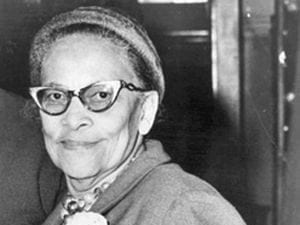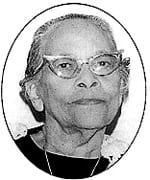In an effort to remain accountable to communities who have been negatively impacted by past and present medical injustices, the staff at Himmelfarb Library is committed to the work of maintaining an anti-discriminatory practice. We will uplift and highlight diverse stories throughout the year, and not shy away from difficult conversations necessary for health sciences education. To help fulfill this mission, today's blog post will cover Mabel Keaton Staupers, R.N.
Mabel Keaton Staupers was an African-American nurse who, through her relentless advocacy, was successful in ending segregation practices in the military during World War II. She also worked within her community to provide African-Americans access to adequate healthcare within their neighborhoods. Born in Barbados in 1890, Staupers immigrated to the United States with her mother in 1903 and her father joined them several years later. They lived in New York City, but in 1917, Staupers studied at the Freedmen's Hospital School (which is now part of Howard University) in Washington DC where she earned her R.N. degree.
As a registered nurse, Staupers immediately began to work to meet the needs of the African-American communities in New York City and Washington D.C. Together with Dr. Louis T. Wright and Dr. James Wilson, she helped establish the Booker T. Washington Sanatorium in Harlem, which treated tuberculosis patients. She also performed a study on the health care needs of Harlem residents. This information eventually led to the creation of the Harlem Committee of the New York Tuberculosis and Health Association, where she served as the organization’s first executive secretary for twelve years. Staupers advocacy work extended beyond issues that affected her neighborhood and into issues that impacted African-American nurses throughout the country. Staupers served as the Executive Secretary for the National Association of Colored Graduate Nurses (NACGN), a professional organization for African-American nurses at the time. Though the NACGN was eventually dissolved in the 1960s when African-American nurses were allowed to enroll in national, state and local nursing organizations that previously excluded them, NACGN and Staupers played a role in addressing the concerns of Black nurses at the time.
Mabel Keaton Staupers continued her advocacy work and her efforts eventually led to the ending of a discriminatory practice within the military. During World War II, nurses were allowed to enroll in the military, but the Army and Navy set a quota for the number of African-American nurses who were allowed to enlist. Staupers organized a letter writing campaign that encouraged President Franklin D. Roosevelt and other political leaders to eliminate the quota policy for Black nurses. Staupers also met with the president’s wife, Lady Eleanor Roosevelt to bring awareness to her cause. The discriminatory policy was repealed in 1945 and Black nurses were allowed to freely enlist in the military.
Because of her advocacy work, in 1951, Mabel Keaton Staupers was awarded the Spingarn Medal from the National Association for the Advancement of Colored People (NAACP). The award recognizes African-Americans who have significantly contributed to uplifting the needs of the African-American community. Staupers also documented her experiences with ending the discriminatory practices in the military in a book titled, No Time for Prejudice: A Story of the Integration of Negroes in Nursing in the United States. Staupers eventually returned to Washington DC, where she lived until her death in 1989 at the age of 99.
Mabel Keaton Staupers is an excellent example of using your knowledge and expertise to directly address the needs of your local community. Staupers understood that the medical needs of the African-American community was not being addressed by the broader medical community, but through collaboration and dedication to her cause, she not only provided medical care to her local community, but also fought against the discriminatory practices that prevented Black nurses from serving in their full capacity. Her story highlights the importance of uncovering your interests and seeing where those interests intersect with a need within your community. By working with others, you can greatly improve the conditions of your community. If you’re interested in learning more about Mabel Keaton Staupers, R.N. visit our catalog for articles relating to this important woman. And be sure to read her book, No Time for Prejudice, to hear about her experiences in her own words.
Bibliography:
- Staten, Candace. “Mabel Keaton Staupers (1890-1989) •.” BlackPast, 31 Mar. 2011, www.blackpast.org/african-american-history/staupers-mabel-keaton-1890-1989.
- The Editors of Encyclopaedia Britannica. “Mabel Keaton Staupers | American Nurse and Executive.” Encyclopedia Britannica, 23 Feb. 2021, www.britannica.com/biography/Mabel-Keaton-Staupers.
- “Mabel Keaton Staupers, R.N., 1890-.” Journal of the National Medical Association, vol. 61, no. 2, 1969, pp. 198–99, www.ncbi.nlm.nih.gov/pmc/articles/PMC2611696/?page=1.




